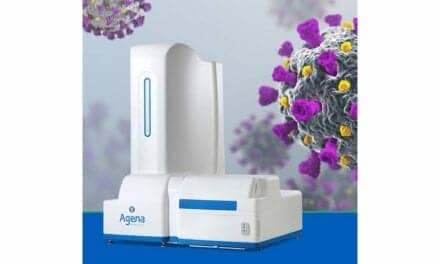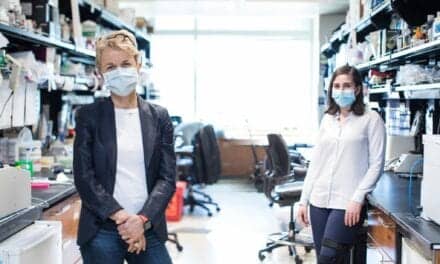The molecular biology reagent and enzyme provider developed a COVID employee testing program that has allowed the company to keep its operations up and running, while verifying the efficacy of its first RUO diagnostic product.
By Chris Wolski
At the dawn of the COVID-19 pandemic, the 50-year-old New England Biolabs (NEB), a provider of reagents and enzymes for molecular biology, was faced with the same challenge as many other diagnostic providers: how to remain operational while keeping its employees safe.
The answer was as effective as it was unique, the company developed its own RUO diagnostic product that it was able to use to quickly and effectively test its employees and remain up and running.
CLP recently sat down with Nathan Tanner, PhD, a senior scientist with NEB, about how the company implemented its employee testing program, why NEB needed to develop its own test, the staff’s reaction to the testing program, the program’s future, and the future of COVID testing in general.
The following answers have been edited for length and clarity.
CLP: NEB started an employee testing program during the COVID pandemic—how did it work, and what diagnostic tools did it employ?
Nathan Tanner: We started offering an employee testing program in Fall 2020, as it was critical to our operations to have staff on site safely. For approximately the first six months, we used a commercial testing service which worked well, but required time for shipping samples to the lab and results took 24-48 hours. A focus for our research work had been increasing access to molecular diagnostics through our colorimetric LAMP isothermal amplification tools and technologies, and those efforts increased substantially early in 2020 due to a clear global need for expanded diagnostics. Using saliva to avoid swab and RNA extraction supply bottlenecks was attractive, and as that gained momentum we first began an IRB program to validate our LAMP kit with real saliva. That matured as our on-site testing needs continued and we transitioned off of paying for a testing service and instead began doing it ourselves with NEB employees running tests using NEB reagents.
CLP: What was the reaction of the employees—did they embrace it? How did leadership help with acceptance? What would happen if there was a positive result?
Tanner: [The reaction to the program was] extremely positive. We have a close-knit community here and everyone wanted to be back together making enzymes and doing science. Ensuring that could be done safely was hugely important for minimizing operational risk and maintaining everyone’s sense of security. It was important to instill a trust in the performance and reliability of our test, which our leadership highlighted whenever possible. Once our lab and test were operating under CLIA we could release results directly to the employee—positives are confirmed in repeat testing and released immediately to the employee and their supervisor, any potential contacts notified, etc. Return to work also requires a quarantine period and negative test result from our lab, and in the approximately 16 months we’ve been running tests this has all been optimized and works well.
CLP: COVID testing in general seems to be waning—will NEB continue its program? Why or why not? If so, what advice would you give to other labs and health organizations about setting up a testing program and, more importantly, keeping it going?
Tanner: Yes, we plan to continue for the foreseeable future. By quickly identifying potentially contagious employees we can minimize workplace transmission and ensure our operation continues efficiently and safely. We additionally benefit from real-time validation of our LAMP diagnostics reagents and our NGS library prep and sequencing reagents, making sure they continue to perform with new and changing variants. Knowledge of case numbers, and potential on-site transmission events as determined by sequencing enable us to adjust masking and other policies on our campuses.
CLP: I know that NEB is interested in public health, particularly because most people in the U.S. are less focused on the public health side of COVID. It’s much more about protecting themselves and loved ones—how do you think we should be reframing that?
Tanner: Supporting public health initiatives, particularly neglected tropical disease, has long been a fundamental priority for NEB. We’ve had research groups focused on filariasis for more than 35 years. Enabling low-cost, fieldable diagnostics was a big driver in our efforts to develop robust LAMP isothermal chemistry, which extended into direct saliva testing for SARS-CoV-2. We continue to support this work with our research labs and have donated reagents for LAMP testing programs in South America and Africa. Yale University developed a saliva-based RT-qPCR COVID test, the “Saliva Direct” protocol, and uniquely validate labs to run the tests using a variety of instruments and reagents from vendors including NEB. This is a new model to expand testing access and supporting programs like these is strongly aligned with NEB’s mission. We feel that access to diagnostics should be available to everyone, and we all benefit from better detection and healthcare tools.
CLP: What do you think are the main takeaways about public testing that we should have learned from COVID? What do you think public testing is going to look like in five years?
Tanner: COVID has certainly impacted how we think about pandemic response and public health measures, even moving us to running our own on-site CLIA lab test for NEB employees. The general public is much more familiar with the power and utility of molecular testing, with some LAMP tests even available for at-home use. The sheer number of daily COVID tests will likely decrease from its peak but not go away, and the public will likely expect to have more indications available, and we expect development of more accessible at-home and point-of-care tests for influenza, strep, and STIs. More people testing more often can be a huge boon to public health if done well and reliably, and we hope to help bring that future about.
Featured image: The NEB employee testing program workflow allowed the company to keep its doors open during the height of the pandemic. The company plans to continue the program for the foreseeable future. Image: NEB
Chris Wolski is chief editor of CLP.





